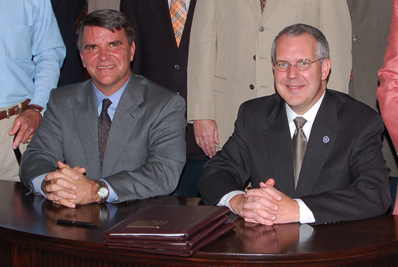Conservation Reserve Enhancement Program
Oklahoma Governor and U.S. Deputy Sec. of Agriculture Sign Conservation Agreement
Oklahoma City, OK, April 23, 2007 – Oklahoma Governor Brad Henry and Deputy Agriculture Secretary Chuck Conner today signed a new $20.6 million cooperative conservation partnership agreement between USDA and Oklahoma that will create up to 9,000 acres (or 370 miles) of riparian buffers and filter strips. The conservation plantings will reduce the flow of nutrients, sediment and other pollutants in the Spavinaw Lake and Illinois River/Lake Tenkiller watersheds (Oklahoma CREP).

“I’m pleased to announce this new Conservation Reserve Enhancement Program,” said Deputy Sec. Conner. “Through this project, USDA and the state of Oklahoma will help landowners and operators establish effective conservation practices to enhance water quality in eastern Oklahoma.”
“It is a historic day for Oklahoma to be awarded this Conservation Reserve Enhancement Program as we begin our second century of statehood,” Gov. Henry said. “Soil conservation was born in Oklahoma. The partnership between private landowners and our conservation districts has demonstrated that voluntary, locally-driven conservation can successfully address significant environmental issues like the Dust Bowl and now water quality,” Gov. Henry said. “With the establishment of this Conservation Reserve Enhancement Program, we reaffirm our state’s commitment to assist private landowners to practice conservation on Oklahoma’s working lands for the next 100 years,” Henry said.

Conner and Gov. Henry signed the project agreement during a special ceremony today at the Oklahoma Capitol Building in Oklahoma City. Key CREP partners also include the Oklahoma Conservation Commission (OCC), City of Tulsa’s Metropolitan Utility Authority, Oklahoma Scenic Rivers Commission, five local conservation districts, the USDA Farm Service Agency (FSA) and USDA Natural Resources Conservation Service (NRCS).
“Our water resources in northeastern Oklahoma are key to the economy of Tulsa and the entire state,” said Tulsa Mayor Kathy Taylor. “This Conservation Reserve Program agreement helps to guarantee the future of our state and the Tulsa metropolitan area by assisting in the enhancement of water quality. The Best Management Practices endorsed and funded by this program will enable our citizens to play an active role in promoting high water quality for northeastern Oklahoma for years to come. This guarantee is essential for business growth and quality of life,” Mayor Taylor said.
“It has been a long, hard road to get the Conservation Reserve Enhancement Program underway” said Bill Blackard, chair of the Oklahoma Scenic Rivers Commission. “The Scenic Rivers Commission is excited to invest some of its resources in this project. With this agreement we will be able to access four federal dollars for every state and local conservation dollar we spend. In the long run our children and our children’s children will reap the environmental benefits of the investment we make today,” Blackard said.
“Spavinaw Lake is the primary water supply for our second largest city. The Illinois River is our most iconic scenic river,” said Miles Tolbert, state Sec. of Environment. “These waters both face serious challenges. With the creation of a CREP we are rising to that challenge,” Tolbert said.
The Oklahoma CREP includes parts of Adair, Cherokee, Delaware, Mayes and Sequoyah counties and includes participation by the conservation districts in those counties. The project seeks to filter runoff, stabilize stream banks, shade stream channels, and improve drinking water and aquatic habitat by creating 500 acres of filter strips and 8,500 acres of riparian buffers, for a total of 9,000 acres, or 370 miles, of protected streams.
Land owners participating in the program will receive annual rental payments, financial and technical assistance and other incentives for voluntarily enrolling land into contracts. FSA will administer Oklahoma CREP, with support from state CREP partners. Eligible landowners will receive a one-time Practice Incentive Payment and a one-time Signing Incentive Payment. In addition, federal dollars will pay 50 percent of the reimbursable costs of establishing eligible practices, conducting compliance reviews, and providing technical assistance and other services up to $16.5 million for Oklahoma CREP.
“Farmers and ranchers are the original conservationists. They have to constantly conserve and enhance their land to keep it productive. They live on the land and are intimately tied to it,” said Terry Peach, state Sec. of Agriculture. “In this modern world of global trade however, it’s not always so easy for a farmer to make a living and still give back to the land what it needs. This CREP program will allow the farmers of these two watersheds to achieve both purposes and all the citizens of Oklahoma will reap the reward,” Peach said.
OCC is the state agency that will oversee implementation of the program. OCC, collaborating with local conservation districts, will identify eligible producers with appropriate land for enrollment in the program. The state will provide payments to participants and pay a minimum of 20 percent of the overall costs of the Oklahoma CREP, including payments for fencing and related costs for non-Conservation Reserve Program (CRP) acreage. OCC will also provide staffing for the project, and coordinate with other natural resource conservation programs at the local, state and federal levels. The state will provide $4.1 million in cash and in-kind services for Oklahoma CREP.
“The Conservation Commission and local conservation districts have been helping to implement conservation practices to protect water quality for years,” said Mike Thralls, executive director of the Oklahoma Conservation Commission. “Utilizing programs like CREP is the next logical step in implementing that water quality conservation,” Thralls said.
USDA will announce sign-up for Oklahoma CREP at a future date. USDA will accept offers for contracts under this CREP on a first-come/first-served basis until the 9,000-acre goal is achieved or until Dec. 31, 2007, whichever comes first. More information about the program can be found in the Oklahoma CREP fact sheet posted online at http://www.fsa.usda.gov; click on Find FSA Fact Sheets.
